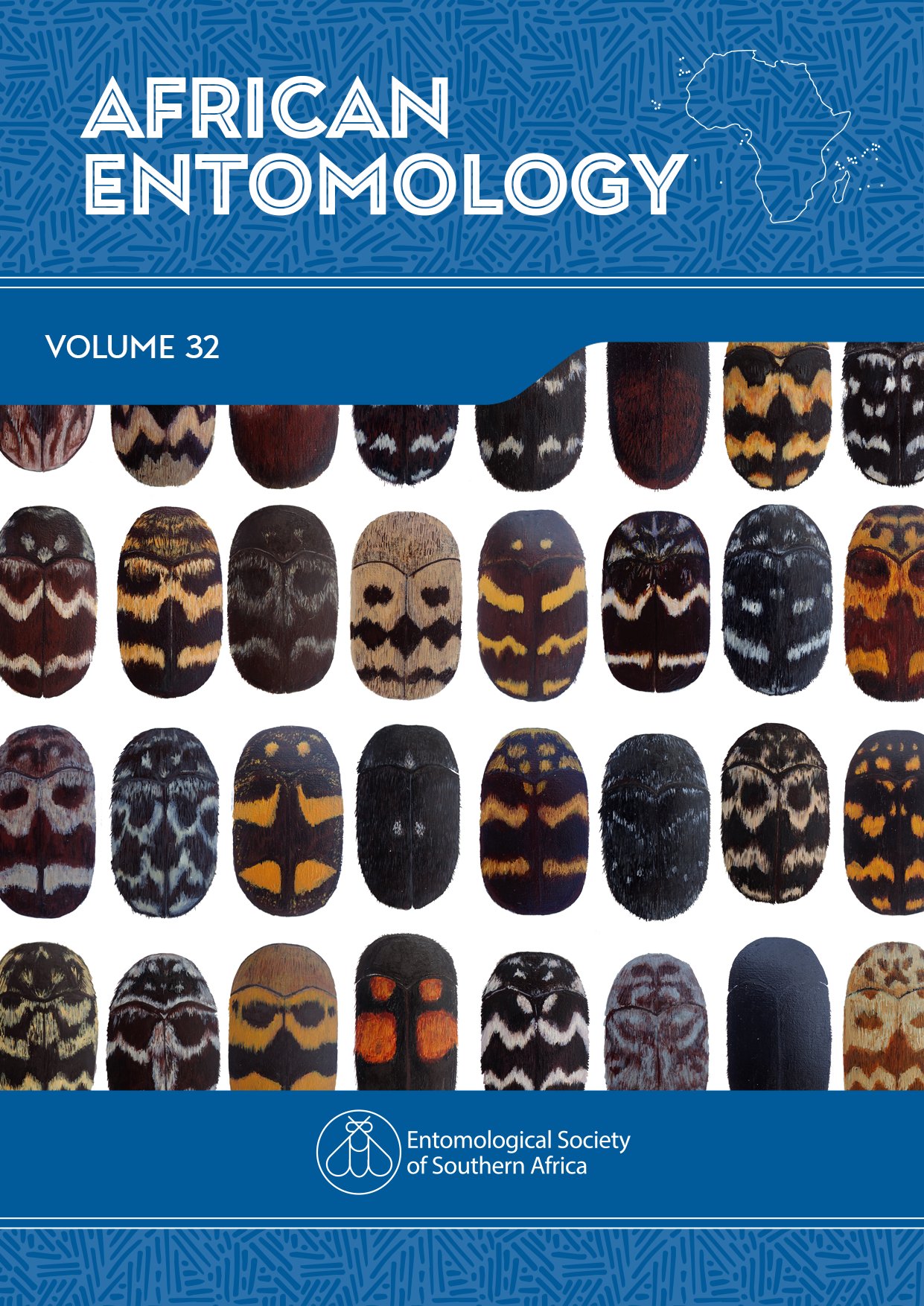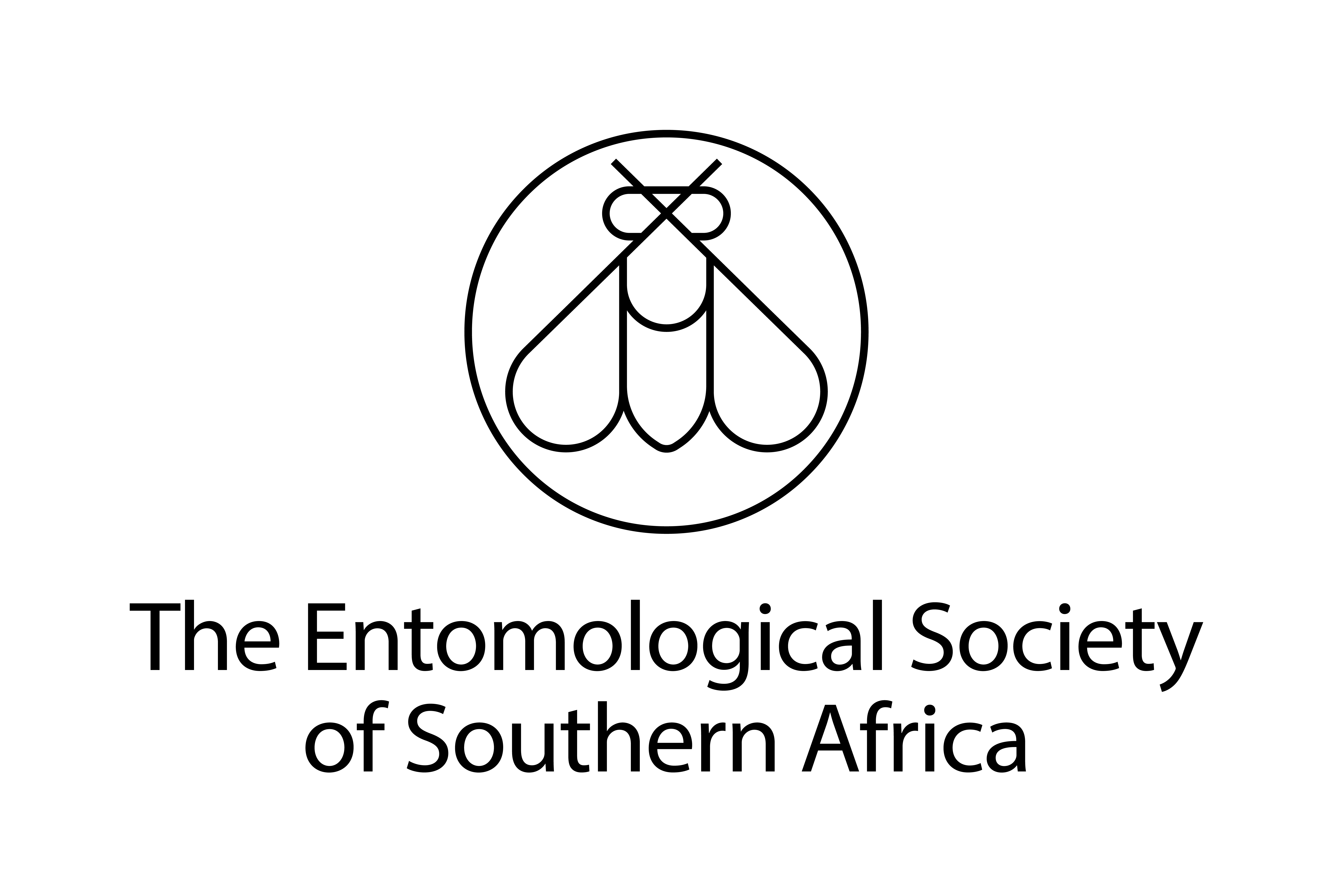Relative abundance and damage by species in the Lepidoptera borer complex of macadamia nuts in the Barberton area, South Africa
DOI:
https://doi.org/10.17159/2254-8854/2024/a17430Keywords:
macadmia pests, Beaumont, Tortricidae, Pest Complex, PyralidaeAbstract
Larvae of the nut borer complex, which include Thaumatotibia leucotreta, T. batrachopa, Cryptophlebia peltastica and Ectomyelois ceratoniae, cause extensive economic damage to macadamias in South Africa. Monitoring the changing species composition in this complex over a growing season provides valuable information for managing populations. In this study, pheromone traps were placed in two orchards planted with two different cultivars and used to monitor moth numbers over a 28-week period, while larval numbers and nut damage were monitored weekly over a 21-week period from the onset of flowering. Larvae were identified using a combination of morphology and DNA sequences of ~658 bp of the cytochrome oxidase I (COI) gene. Both larval and moth numbers were dominated by T. leucotreta, followed by T. batrachopa, with respective trap catches of 69% and 27%. Spearman correlations indicated strong linear relationships between nut diameter and numbers of eggs per nut for both the Beaumont and 816 cultivars. Poor correlations were found between weekly moth numbers and the number of eggs per nut. A two- to three-week lag was observed between weekly T. leucotreta trap catches and egg numbers. In contrast, egg numbers correlated strongly with larval infestation levels and the incidence of damaged nuts. Although the numbers of eggs and larvae were higher in Beaumont than cv. 816 nuts, higher incidences of nuts with husk and kernel damage were recorded for cv. 816. This study highlights the importance of monitoring of moth and larval numbers in macadamia orchards and showed that such data could be used to predict pest incidence during the season. This study questions the norm in South Africa, which is that macadamia nut borer (MNB) is usually the most abundant species in the nut borer complex.
Downloads
References
Adom M, Fening K, Billah M, Wilson D, Hevi W, Clottey V, Ansah-Amprofi F, Bruce A. 2021. Pest status, bio-ecology and management of the false codling moth, Thaumatotibia leucotreta (Meyrick) (Lepidoptera: Tortricidae) and its implication for international trade. Bulletin of Entomological Research. 111:17–30. https://doi.org/10.1017/S0007485320000358
Brown JW, Copeland RS, Aarvik L, Miller SE, Rosati ME, Luke Q. 2014. Host records for fruit-feeding Afrotropical Tortricidae (Lepidoptera). African Entomology. 22(2):343–376. https://doi.org/10.4001/003.022.0225
Bruwer I. 2001. Integrated Pest Management. Grower’s Handbook. Nelspruit: South African Macadamia Association (SAMAC).
Daiber CC. 1976. A survey of the false codling moth (Cryptophlebia leucotreta Meyr.) in peach orchards. Phytophylactica. 8:97–102.
De Villiers E. 2001. Carob moth. In: Van den Berg MADV and Joubert P. (eds.) Pests and Beneficial Arthropods of Tropical and Non-citrus Subtropical Crops in South Africa. Nelspruit: Agricultural Research Council. pp. 317–320.
du Preez F, Malan AP, Addison P. 2021. Potential of in vivo- and in vitro-cultured entomopathogenic nematodes to infect Lobesia vanillana (Lepidoptera: Tortricidae) under laboratory conditions. PLoS One. 16(8):p.e0242645. https://doi.org/10.1371/journal.pone.0242645
Hebert PDN, Penton EH, Burns JM, Janzen DH, Hallwachs W. 2004. Ten species in one: DNA barcoding reveals cryptic species in the neotropical skipper butterfly Astraptes fulgerator. Proceedings of the National Academy of Sciences of the United States of America. 101:14812–14817. https://doi.org/10.1073/pnas.0406166101
IBM. 2021. IBM Corp. Released 2021. IBM SPSS Statistics for Windows, Version 28.0.1.1. Armonk & New York: IBM Corp.
Insect Science. 2022. Insect Science (Pty) Ltd. Tzaneen, South Africa. https://insectscience.co.za.
Jones VP, Caprio LC. 1992. Damage estimates and population trends of insects attacking seven macadamia cultivars in Hawaii. Journal of Economic Entomology. 85:1884–1890. https://doi.org/10.1093/jee/85.5.1884
Jones VP. 1994a. Oviposition patterns of koa seedworm and litchi fruit moth (Lepidoptera: Tortricidae) on macadamia and litchi in Hawaii. Journal of Economic Entomology. 87:1278–1284. https://doi.org/10.1093/jee/87.5.1278
Jones VP. 1994b. Feeding by Cryptophlebia illepida and C. ombrodelta (Lepidoptera: Tortricidae) on macadamia nut abortion. Journal of Economic Entomology. 87:781–786. https://doi.org/10.1093/jee/87.3.781
Jones VP. 1995. Sampling plans for Cryptophlebia spp. (Lepidoptera: Tortricidae) attacking macadamia and litchi in Hawaii. Journal of Economic Entomology. 88:1337-1342. https://doi.org/10.1093/jee/88.5.1337
Joubert AJ. 1986. ’n Vergelykende morfogenetiese studie van Macadamia integrifolia (Maiden & Betche) en Faurea speciosa (Welw) (Proteaceae). Unpublished PhD. thesis, University of Pretoria, Pretoria, South Africa. 161 pp.
La Croix E, Thindwa H. 1986. Macadamia pests in Malawi. III. The major pests. The biology of bugs and borers. International Journal of Pest Management. 32:11–20. https://doi.org/10.1080/09670878609371019
La Croix EAS. 1990. Studies on macadamia nut borer (Cryptophlebia spp.) in northern Malawi. Tropical Pest Management. 36:97–102. https://doi.org/10.1080/09670879009371450
Lösel PM, Potting RPJ, Ebbinghaus D, Scherkenbeck J. 2002. Factors affecting the field performance of an attracticide against the codling moth Cydia pomonella. Pest Management Science. 58(10):1029–1037. https://doi.org/10.1002/ps.577
Mediouni J, Dhouibi M. 2007. Mass-rearing and field performance of irradiated carob moth Ectomyelois ceratoniae in Tunisia. In: Vreysen MJB, Robinson AS, Hendrichs J (eds), Area-Wide Control of Insect Pests. Dordrecht: Springer. https://doi.org/10.1007/978-1-4020-6059-5_25
Mlanjeni N, Moore S, Richards G. 2002. Investigation of the macadamia nutborer species complex and the natural enemies of their larvae in South Africa. Yearbook of the Southern African Macadamia Growers Association. 10:62–71.
Mlanjeni N, Richards G, Villet M, Moore S. 2004. Investigation of the macadamia nutborer species complex and the natural enemies of their larvae in South Africa. Unpublished report, Rhodes University and Citrus Research International. Gqeberha: Citrus Research International. pp.88.
Moore SD, Hattingh V. 2012. A review of current pre-harvest control options for false codling moth in citrus in Southern Africa. South African Fruit Journal. 11:82–85.
Morland G. 2015. The morphology and ecology of the Carob moth (Ectomyelois ceratoniae) (Zeller) in citrus orchards of the Western Cape, South Africa. Unpublished MSc dissertation, Stellenbosch University, South Africa.
Morland G, Geertsema H, Addison P. 2019. Monitoring seasonal activity and damage potential of the carob moth Ectomyelois ceratoniae (Lepidoptera: Pyralidae: Phycitinae) in citrus orchards of the Western Cape Province. African Entomology. 27:75–85. https://doi.org/10.4001/003.027.0075
Namba R. 1957. Cryptophlebia illepida (Butler) (Lepidoptera: Eucosmidae) and other insect pests of the macadamia nut in Hawaii. Proceedings of the Hawaiian Entomological Society. 16(2):284–297. http://hdl.handle.net/10125/14906
Newton P, Crause C. 1990. Ovipositoin on Litchi chinensis by Cryptophlebia species (Lepidoptera: Tortricidae). Phytophylactica. 22:365–367.
Schoeman PS, de Viliers EA. 2015. Macadamia. In: Prinsloo G, Uys V (eds), Insects of cultivated plants and natural pastures in Southern Africa. Pretoria: Entomological Society of Southern Africa.
SAMAC. 2022. Industry statistics. https://samac.org.za/industry-statistics/ [accessed 19 November 2022].
Schoeman PS. 2009. Key biotic components of the indigenous Tortricidae and Heteroptera complexes occurring on macadamia in South Africa. Unpublished PhD thesis, North-West University, South Africa.
Schoeman PS. 2016. Influence of canopy density and height on Tortricidae moths affecting macadamia in South Africa. African Entomology. 24:407–411. https://hdl.handle.net/10520/EJC195086
Schoeman S. 2021. Management of the Tortricidae complex on macadamia. SAMAC, https://southafrica.co.za/macadamias-south-africa.html.
Schwartz A. 1981. ‘n Bydrae tot die biologie en beheer van die valskodlingmot Cryptophlebia leucotreta (Meyr.) (Lepidoptera: Eucosmidae) op nawels. Unpublished PhD thesis, University of Stellenbosch, Stellenbosch, South Africa. 280 pp.
Smith AK, Slippers B, Hurley BP, Fourie G. 2022. Diversity of Lepidoptera associated with macadamia nut damage in South Africa and development of molecular tools to monitor pest populations. Agricultural and Forest Entomology. 24(3):332–343. https://doi.org/10.1111/afe.12497
Timm A, Warnich L, Geertsema H. 2007. Morphological and molecular identification of economically important Tortricidae (Lepidoptera) on tropical and subtropical fruit in South Africa. African Entomology. 15:269–286. https://doi.org/10.4001/1021-3589-15.2.269
Venette RC, Davis EE, Dacosta M, Heisler H, Larson M. 2003. Mini risk assessment false codling moth, Thaumatotibia (Cryptophlebia) leucotreta (Meyrick) (Lepidoptera: Tortricidae). University of Minnesota, Department of Entomology, Minnesota, USA, CAPS PRA. pp. 1–30.
Waite G, Hood S, Parker R. 1999. Studies on the ecology of fruitspotting bugs (Amblypelta spp.) (Heteroptera: Coreidae) and Macadamia nut borer (Cryptophlebia ombrodelta) to improve their management in macadamias in Australia. Proceedings of the 1st International Macadamia Symposium in Africa. Mpumalanga Parks Board, Nelspruit, South Africa, September 1999. pp 27–30.
Witzgall P, Kirsch P, Cork A. 2010. Sex pheromones and their impact on pest management. Journal of Chemical Ecology. 36:80–100. https://doi.org/10.1007/s10886-009-9737-y
Downloads
Published
Issue
Section
License
Copyright (c) 2024 Marnus Enslin, Schalk Schoeman, Alicia Timm, Hannalene du Plessis, Johnnie Van den Berg

This work is licensed under a Creative Commons Attribution 4.0 International License.




.png)